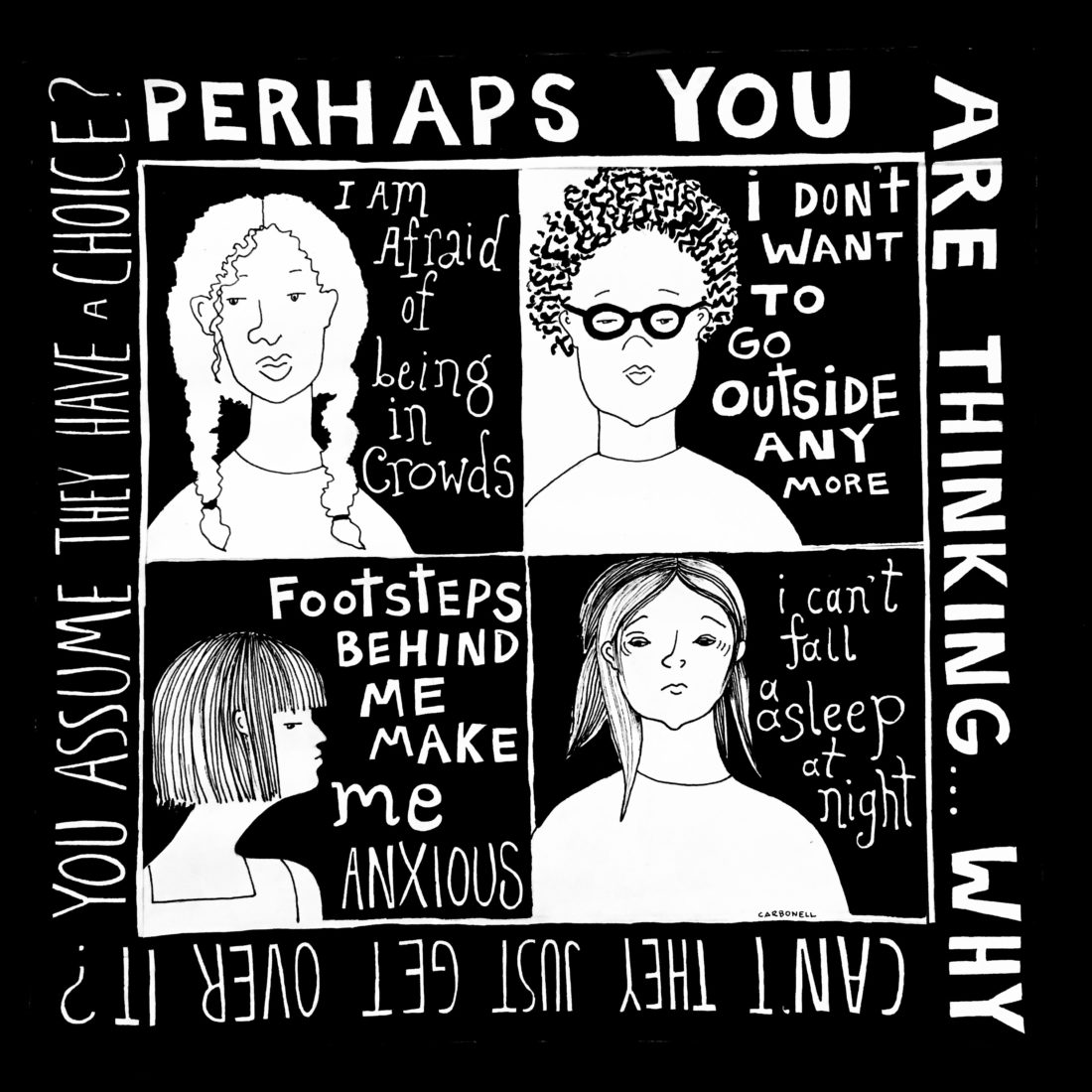This could be true of monsters under the bed or looming panic attacks or secrets shoved into a literal or figurative closet: “The more we name it, the less power we give it,” says Angélica Wind. The executive director of Our VOICE, a local nonprofit serving those in Buncombe County who have been affected by sexual assault and abuse, is speaking to specifying trauma, its perpetrators and its effects.
“Sexual violence is one of the most underreported crimes, and it’s a crime that’s allowed to continue by the silencing,” Wind says. “It wasn’t ‘something bad that happened to this person.’ We should be clear and say, ‘This person was raped,’ because the more we sanitize it, the more we’re giving the impression that we’re minimizing it. We’re naming it for the brutality that it is.”
While at press time, submissions for this year’s Survivors’ Art Show — an annual fund- and awareness-raiser for Our VOICE — were still coming in, Wind pointed to a strong theme of calling out the violence. This year, the 17th for the event, features the work of local designer Denise Carbonell, “whose artwork is really breaking that silence,” says Wind. Carbonell is “naming the power of survivors, in their ability not only to survive but to thrive, but she’s also naming the other pieces [of the aftermath of trauma] that are often silenced.”
The graphic images depicting women of various walks of life offer personal truths such as “I can’t fall asleep at night” and “I’m afraid of being in crowds” — the lingering imprint of abuse long after the initial shock has faded.
Although Carbonell’s work is pitch-perfect for the mood of this year’s Survivors’ Art Show, it’s actually, “something I’ve been doing since the late ’80s,” she says. Around the same time in her career, Carbonell was also producing comic strips for Mademoiselle and PAPER magazines. It was fun, she says, but she wasn’t given free creative rein, so she began her own series based on what she felt most compelled to talk about.
“It was always about women and their struggle in the world — their struggle to be seen in the world as someone of value,” Carbonell says of her images. Although she’s been working with those topics of identity, safety and the aftermath of trauma for several decades, the #MeToo movement made it easier, in a way, she says. “People stopped saying, ‘Are you OK? What’s going on?’ every time I’d post things. It wasn’t autobiographical. … It’s not that it wasn’t necessarily similar to something that might have happened to me, but it’s not my life story.”
She continues, “It’s most women’s story, most trans people and anyone who struggles to have an identity today.”
As stories come to light, those unearthing them or seeking to heal need support. Over the last fiscal year, Our VOICE experienced a 26 percent increase in survivors accessing services through the organization, says Wind. Around the time of Bill Cosby trial for sexual assault and the confirmation hearing for then-Supreme Court nominee Brett Kavanaugh, who also was accused of sexual assault, “What we experienced was [an additional] 25 percent increase in calls,” says Wind. “Where we saw an uptick was the beginning of the #MeToo movement last October. … The #MeToo movement really allowed for survivors to come out of the shadows and disclose.”
The movement, she adds, started to shift the response to those survivors. “The more affirmative a community was … the more other survivors felt they could come and disclose. Many were accessing services for the first time,” says Wind. “It’s really great as long as we continue to foster the type of community where survivors can disclose.”
Along with holding conversations about consent, says Wind, it’s important to allow spaces for survivors to express themselves. However, she points out, there’s often an idea that healing looks a certain way or can only be achieved through traditional modalities, such as talk therapy. Part of the creation of the Survivors’ Art Show was to provide a platform for alternative methods of recovery. “Sometimes you can’t find the words to process what you’re feeling, but you may be able to do it through a painting, through a collage,” Wind says. At the Nov. 15 show, along with visual art, there will also be music and dance.
The other component of the exhibition is a platform dedicated to breaking the silence around sexual assault. “When we work with survivors, we always say, ‘This is a horrible thing that happened to you, but it doesn’t define who you are as a person,’” says Wind. “We wanted to provide an opportunity and a space where survivors can fully express themselves. They don’t often get those opportunities.”
As a society, Wind continues, we want to hear that a survivor is doing better. “We don’t want to hear that they had a bad day,” she says. But work such as Carbonell’s allows for the multitude of experiences — from grief and fear to dark moments and lingering anxiety — to be witnessed.
That doesn’t mean the Survivors’ Art Show is mired in sadness. “It’s very uplifting,” says Wind. For the general public, “Just by attending and being there, shoulder to shoulder with survivors, we’re in solidarity with survivors.”
WHAT: Our VOICE presents the 17th annual Survivors’ Art Show, ourvoicenc.org
WHERE: REVOLVE, 821 Riverside Drive, No. 179
WHEN: Opening reception Thursday, Nov. 15, 6 p.m. Exhibition remains on view for two weeks. Donations accepted




I thought the #metoo movement ended with Kavanaugh?